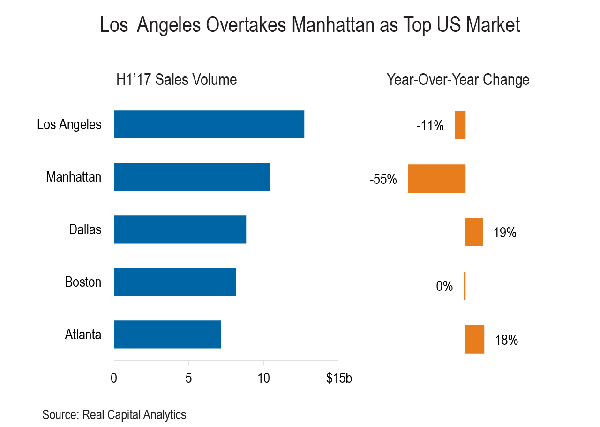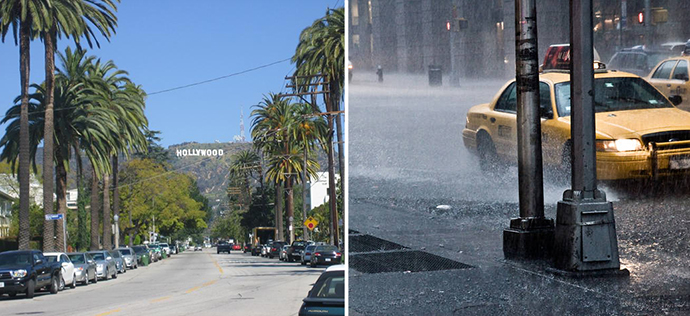From TRD New York: Los Angeles took over the top spot as the country’s largest investment market in the first half of 2017, as Manhattan investment sales tumbled by 55 percent, according to research firm Real Capital Analytics.
The ballpark numbers are preliminary and could change slightly before RCA releases its report next week, but are unlikely to change much, said RCA’s Jim Costello. Los Angeles saw around $13 billion in commercial real estate sales close in the first half of the year, followed by Manhattan with almost $11 billion (see chart). In the first half of 2016, investors had closed on $23.9 billion worth of Manhattan property deals.
Market observers say the stark decrease reflects a gap between sellers who are emboldened by last year’s record deals and want to cash in and increasingly cautious buyers who no longer want to pay peak-market prices.
The result has been more sellers taking their properties off the market after testing the waters, some deciding to take advantage of low interest rates and refinance instead. For example, Walton Street Capital last month abandoned plans to sell its 49 percent stake in 237 Park Avenue and refinanced the building with an $850 million mortgage.
The first half of 2017 saw only two $1 billion-plus commercial property trades in Manhattan: HNA Group’s acquisition of 245 Park Avenue for $2.21 billion and GIC’s 95 percent stake purchase in Deutsche Bank’s headquarters at 60 Wall Street for $1.04 billion.
“There is stuff that is still being priced basically (on the level of) a year and a half ago that’s not moving,” said Greg Kraut of real estate investment firm K Property Group. Most investors no longer expect property prices to rise in the near future as the market cycle nears its end, making it “harder and harder to justify” low cap rates, Kraut said.
Sources said that, over the past year-and-a-half, core properties in Manhattan would often sell at cap rates of slightly above 4 percent. Now buyers often won’t go beyond pricing that translates to cap rates of close to 5 percent, which is more in line with Manhattan’s long-run average rate.

In Los Angeles, meanwhile, deal volume fell 11 percent from $14.6 billion a year ago, but it was enough to take over the top spot as the country’s largest market ahead of Manhattan, Dallas, Boston and Atlanta.
“Buyers just aren’t willing to make as many big bets,” Costello said, blaming a range of factors including uncertainty over federal tax policy. “Why make a big bet if you don’t know what will happen to your interest deductibility,” he said, adding that he expects deal volume to remain low for the rest of the year.
Other observers are more optimistic, arguing there’s still plenty of demand for Manhattan properties amid decent leasing activity and employment growth. “For stuff that’s priced well, it moves,” Kraut said.
Hodges Ward Elliott’s Daniel Parker, who recently brokered the $126 million sale of a Midtown South office building at 31 West 27th Street to Savanna, said he expects deal volume to grow again in the second half of the year because sellers have already become more realistic in their pricing.
“Twelve to 18 months ago, there was a bigger disconnect between buyers and sellers. Now we are seeing more sellers who acknowledge the state of the market,” Parker said. “There is no argument that 2017 sales volume is down overall in the market, but investors can’t sit on the sidelines forever.”
